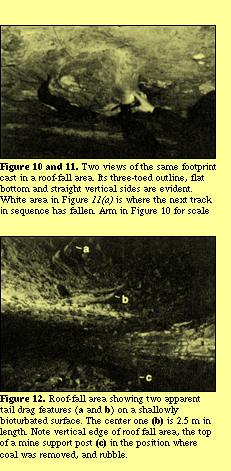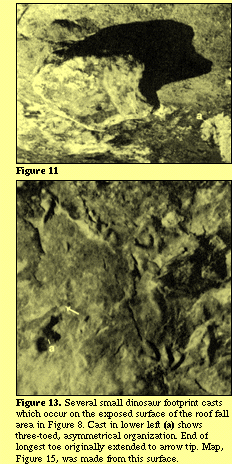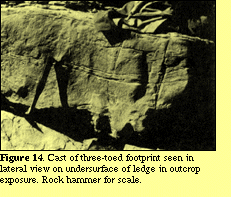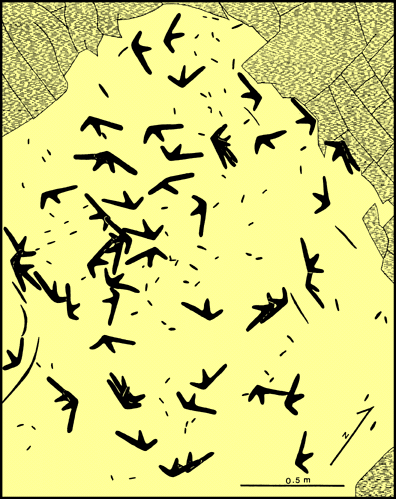|
Tracks which are different from the morphology of the rest of the footprints we have seen occur in one rock fall area (Fig. 13).They are on the recently exposed surface in Figure 8. A map has been prepared (Fig. 15), showing at least 50 of these specimens in an area 2 x 2.5 m. They were produced by a three-toed animal with a distinctly asymmetrical foot. One lateral toe is long and slender, almost 2.5 times the length of the median and opposite lateral toes. Total length from the heel to the end of the longest toe is 15 cm. No claw impressions are evident. Both left and right footprints occur. They apparently were produced by the pedes of a bipedal animal, since no footprints of any other shape or size are present. At least seven clusters of tracks occur where a single foot was being picked up, moved slightly and replaced. This shuffling gait, plus their random orientation, appears similar to tracks of extant birds as they feed on mud-dwelling organisms.Interestingly, associated with these tracks are many small 1 x 2 cm depressions and several thin (1.5 cm wide) elongate striations among the tracks, neither of which have been observed elsewhere in the lacustrine beds. Are these depressions beak or "peck" marks made in the mud by the animal as it fed? |
|||
 |
 |
||
|
Several techniques, inherent in the mining process, limit the observable roof area and in some cases destroy the specimens within the roof. The most common is white "rock dust", a powdered limestone, which is applied as a thick layer onto all freshly exposed mine surfaces in order to reduce the quantity of explosive coal dust. This completely covers all roof features or distorts observation of roof topography with a "snow-blindness" effect. Secondly, "top coal", a layer of coal usually from 10 to 50 cm thick, is left in place on the roof to cover certain types of roof shales which are otherwise subject to "air slacking" (the absorption and subsequent expansion of shales to the point that they fall from the roof). Because of these problems, only about 20% of the roof surface in any mine has been visible for study. But the most serious problem to the study of mine-roof paleontology is the recent development and use of long-wall retreat mining. The equipment in this technique removes coal in long 161 m swaths in such a way that the roof is unsupported and collapses within a few hours in the "gob area" behind the support shields. This completely destroys whatever features might have been preserved in the roof rock and makes studying the areas very hazardous. Because dinosaur footprint casts are abundant in every level of swamp development which we can see underground, why don't they appear in outcrop? We have determined that they are indeed present and common in outcrop but are rarely recognized. For one thing, in lateral view they appear to be load castings which are expected (and present) in these sediments. Additionally, they weather rapidly, destroying characteristic toe and metatarsal features. In fresh exposures, however, and on protected undersurfaces of ledges there are often several intriguing three-lobed structures the same size and shape as those specimens in mine roofs (Fig. 14). We believe that many of these are dinosaur footprints, not load casts. It is clear that the fluvial delta and coastal plain peat-forming environments of the Upper Cretaceous of the Rocky Mountain states had a large and varied dinosaur fauna recognized mainly from their tracks. Coal mines in the Blackhawk Formation of east-central Utah provide a unique opportunity to study their diversity, behavior and paleoecology. |
|||
Acknowledgments We are grateful to Aureal T. Cross of Michigan State University for his infectious enthusiasm, help underground and insightful comments. References Bass, N. W., Eby, J. B., and Campbell, M. R. 1955. Geology and mineral fuels of parts of Routt and Moffat counties, Colorado. U.S. Geol. Surv. Bull.1027-D: 143-250.
Editorial Note: The bird-like tracks illustrated in Figure 15 display morphologies consistent with the asymmetric foot of Hesperomis and its relatives. |
|||
| |||



